Fluid Resuscitation with Lactated Ringer vs. Normal Saline in Acute Pancreatitis: A Systematic Review and Meta-Analysis of Clinical Trials
Abstract
1. Introduction
2. Materials and Methods
2.1. Study Protocol
2.2. Research Question
2.3. Eligibility Criteria
2.3.1. Inclusion Criteria
- Randomized controlled trials, regardless of the specific design (e.g., parallel, crossover) or follow-up duration.
- Publications spanning from the creation date of each database until February 2025, with no language restrictions.
- Studies conducted in adult patients diagnosed with acute pancreatitis that compared the effectiveness of fluid resuscitation with Lactated Ringer versus normal saline, regardless of the volume administered or the duration of therapy.
- Trials with multiple treatment arms where the Lactated Ringer intervention group could be isolated.
- Research reporting at least one of the following outcomes: days of hospitalization, ICU admission, presence of SIRS (at 24, 48, or 72 h), progression of pancreatitis severity, CRP levels, mortality, or adverse events.
2.3.2. Exclusion Criteria
- Conference abstracts, articles in preprint format, or letters to the editor.
- Studies for which the full text was not available in an accessible format.
- Publications that used the same patient cohort as previously included clinical trials for the same purpose.
- Research that did not provide sufficient data for the calculation of the effect estimate.
- Studies conducted in animal models.
2.4. Data Sources and Search Strategy
2.5. Study Selection and Data Extraction
2.6. Risk of Bias Assessment
2.7. Assessment of Evidence Quality
2.8. Statistical Analysis
3. Results
3.1. Studies Identified for the Review
3.2. Characteristics of the Studies Included in the Review
3.3. Characteristics of the Population and the Applied Intervention
3.4. Results of the Risk of Bias Assessment
3.4.1. Random Sequence Generation
3.4.2. Allocation Concealment
3.4.3. Blinding of Participants and Personnel
3.4.4. Blinding of Outcome Assessment
3.4.5. Incomplete Outcome Data
3.4.6. Selective Reporting
3.4.7. Summary of Risk of Bias
3.5. Qualitative Synthesis of the Scientific Evidence
3.5.1. Mortality
3.5.2. Adverse Events
3.6. Meta-Analysis
3.6.1. Results of the Evidence Quality Assessment
3.6.2. Hospital Stay
3.6.3. Admission to Intensive Care Unit
3.6.4. Progression of Pancreatitis
3.6.5. Development of SIRS
SIRS at 24 h
SIRS at 48 h
SIRS at 72 h
3.6.6. CRP Score
CRP at 48 h
CRP at 72 h
3.6.7. Publication Bias
3.6.8. Results of the GRADE Certainty of Evidence Assessment
4. Discussion
4.1. Findings of the Review
4.2. Comparison with Previous Studies
4.3. Limitations of the Studies in the Review
4.4. Limitations of the Review
4.5. Clinical Implications
4.6. Recommendations for Future Studies
5. Conclusions
Supplementary Materials
Author Contributions
Funding
Institutional Review Board Statement
Informed Consent Statement
Data Availability Statement
Acknowledgments
Conflicts of Interest
References
- Iannuzzi, J.P.; King, J.A.; Leong, J.H.; Quan, J.; Windsor, J.W.; Tanyingoh, D.; Coward, S.; Forbes, N.; Heitman, S.J.; Shaheen, A.-A.; et al. Global Incidence of Acute Pancreatitis Is Increasing Over Time: A Systematic Review and Meta-Analysis. Gastroenterology 2022, 162, 122–134. [Google Scholar] [CrossRef]
- Beyer, G.; Hoffmeister, A.; Lorenz, P.; Lynen, P.; Lerch, M.M.; Mayerle, J. Clinical Practice Guideline—Acute and Chronic Pancreatitis. Dtsch. Arztebl. Int. 2022, 119, 495–501. [Google Scholar] [CrossRef]
- Banks, P.A.; Freeman, M.L. Practice Parameters Committee of the American College of Gastroenterology Practice Guidelines in Acute Pancreatitis. Am. J. Gastroenterol. 2006, 101, 2379–2400. [Google Scholar] [CrossRef] [PubMed]
- Trikudanathan, G.; Navaneethan, U.; Vege, S.S. Current Controversies in Fluid Resuscitation in Acute Pancreatitis: A Systematic Review. Pancreas 2012, 41, 827–834. [Google Scholar] [CrossRef] [PubMed][Green Version]
- de-Madaria, E.; Buxbaum, J.L.; Maisonneuve, P.; García García De Paredes, A.; Zapater, P.; Guilabert, L.; Vaillo-Rocamora, A.; Rodríguez-Gandía, M.Á.; Donate-Ortega, J.; Lozada-Hernández, E.E.; et al. Aggressive or Moderate Fluid Resuscitation in Acute Pancreatitis. N. Engl. J. Med. 2022, 387, 989–1000. [Google Scholar] [CrossRef] [PubMed]
- Costea, C.-N.; Pojoga, C.; Seicean, A. Advances in the Management of Fluid Resuscitation in Acute Pancreatitis: A Systematic Review. Diagnostics 2025, 15, 810. [Google Scholar] [CrossRef]
- Buxbaum, J.L.; Quezada, M.; Da, B.; Jani, N.; Lane, C.; Mwengela, D.; Kelly, T.; Jhun, P.; Dhanireddy, K.; Laine, L. Early Aggressive Hydration Hastens Clinical Improvement in Mild Acute Pancreatitis. Am. J. Gastroenterol. 2017, 112, 797–803. [Google Scholar] [CrossRef]
- Alderson, P.; Schierhout, G.; Roberts, I.; Bunn, F. Colloids versus Crystalloids for Fluid Resuscitation in Critically Ill Patients. In Cochrane Database of Systematic Reviews; The Cochrane Collaboration, Ed.; John Wiley & Sons, Ltd.: Chichester, UK, 2000; p. CD000567. [Google Scholar]
- Wilcox, C.S. Regulation of Renal Blood Flow by Plasma Chloride. J. Clin. Investig. 1983, 71, 726–735. [Google Scholar] [CrossRef]
- Reed, A.M.; Husain, S.Z.; Thrower, E.; Alexandre, M.; Shah, A.; Gorelick, F.S.; Nathanson, M.H. Low Extracellular pH Induces Damage in the Pancreatic Acinar Cell by Enhancing Calcium Signaling. J. Biol. Chem. 2011, 286, 1919–1926. [Google Scholar] [CrossRef]
- Lipinski, M. Fluid Resuscitation in Acute Pancreatitis: Normal Saline or Lactated Ringer’s Solution? World J. Gastroenterol. 2015, 21, 9367. [Google Scholar] [CrossRef]
- Hoque, R.; Farooq, A.; Ghani, A.; Gorelick, F.; Mehal, W.Z. Lactate Reduces Liver and Pancreatic Injury in Toll-Like Receptor– and Inflammasome-Mediated Inflammation via GPR81-Mediated Suppression of Innate Immunity. Gastroenterology 2014, 146, 1763–1774. [Google Scholar] [CrossRef]
- Di Martino, M.; Van Laarhoven, S.; Ielpo, B.; Ramia, J.M.; Manuel-Vázquez, A.; Martínez-Pérez, A.; Pavel, M.; Beltran Miranda, P.; Orti-Rodríguez, R.; De La Serna, S.; et al. Systematic Review and Meta-Analysis of Fluid Therapy Protocols in Acute Pancreatitis: Type, Rate and Route. HPB 2021, 23, 1629–1638. [Google Scholar] [CrossRef]
- Jia, R.; Tang, M.; Qiu, L.; Sun, R.; Cheng, L.; Ma, X.; Yin, G.; Hu, G.; Wang, X.; Zhao, Y. Increased Interleukin-23/17 Axis and C-Reactive Protein Are Associated with Severity of Acute Pancreatitis in Patients. Pancreas 2015, 44, 321–325. [Google Scholar] [CrossRef] [PubMed]
- Farrell, P.R.; DesPain, A.W.; Farmer, P.; Farrell, L.M.; Greenfield, B.; Rogers, M.E.; Hornung, L.; Kim, E.; Pearman, R.; Neway, B.; et al. Faster Discharge with Lactated Ringers than Normal Saline in First 72 h of Acute Pancreatitis: A Multicenter Randomized Trial. J. Pediatr. Gastroenterol. Nutr. 2024, 78, 360–368. [Google Scholar] [CrossRef] [PubMed]
- Chen, H.; Lu, X.; Xu, B.; Meng, C.; Xie, D. Lactated Ringer Solution Is Superior to Normal Saline Solution in Managing Acute Pancreatitis: An Updated Meta-Analysis of Randomized Controlled Trials. J. Clin. Gastroenterol. 2022, 56, e114–e120. [Google Scholar] [CrossRef] [PubMed]
- Ocskay, K.; Mátrai, P.; Hegyi, P.; Párniczky, A. Lactated Ringer’s Solution Reduces Severity, Mortality, Systemic and Local Complications in Acute Pancreatitis: A Systematic Review and Meta-Analysis. Biomedicines 2023, 11, 321. [Google Scholar] [CrossRef]
- Rivera-Sanchez, S.P.; Ocampo-Ibáñez, I.D.; Liscano, Y.; Martínez, N.; Muñoz, I.; Manrique-Moreno, M.; Martinez-Martinez, L.; Oñate-Garzon, J. Integrating In Vitro and In Silico Analysis of a Cationic Antimicrobial Peptide Interaction with Model Membranes of Colistin-Resistant Pseudomonas Aeruginosa Strains. Pharmaceutics 2022, 14, 1248. [Google Scholar] [CrossRef]
- Trejos, M.; Aristizabal, Y.; Aragón-Muriel, A.; Oñate-Garzón, J.; Liscano, Y. Characterization and Classification In Silico of Peptides with Dual Activity (Antimicrobial and Wound Healing). Int. J. Mol. Sci. 2023, 24, 13091. [Google Scholar] [CrossRef]
- Aboelsoud, M.M.; Siddique, O.; Morales, A.; Seol, Y.; Al-Qadi, M.O. Fluid Choice Matters in Critically-Ill Patients with Acute Pancreatitis: Lactated Ringer’s vs. Isotonic Saline. R. I. Med. J. 2013 2016, 99, 39–42. [Google Scholar]
- Semler, M.W.; Self, W.H.; Wanderer, J.P.; Ehrenfeld, J.M.; Wang, L.; Byrne, D.W.; Stollings, J.L.; Kumar, A.B.; Hughes, C.G.; Hernandez, A.; et al. Balanced Crystalloids versus Saline in Critically Ill Adults. N. Engl. J. Med. 2018, 378, 829–839. [Google Scholar] [CrossRef]
- Moher, D.; Liberati, A.; Tetzlaff, J.; Altman, D.G. Preferred Reporting Items for Systematic Reviews and Meta-Analyses: The PRISMA Statement. Int. J. Surg. 2010, 8, 336–341. [Google Scholar] [CrossRef]
- Knobloch, K.; Yoon, U.; Vogt, P.M. Preferred Reporting Items for Systematic Reviews and Meta-Analyses (PRISMA) Statement and Publication Bias. J. Cranio-Maxillofac. Surg. 2011, 39, 91–92. [Google Scholar] [CrossRef] [PubMed]
- Higgins, J.P.T.; Altman, D.G.; Gotzsche, P.C.; Juni, P.; Moher, D.; Oxman, A.D.; Savovic, J.; Schulz, K.F.; Weeks, L.; Sterne, J.A.C.; et al. The Cochrane Collaboration’s Tool for Assessing Risk of Bias in Randomised Trials. BMJ 2011, 343, d5928. [Google Scholar] [CrossRef] [PubMed]
- Karki, B.; Thapa, S.; Khadka, D.; Karki, S.; Shrestha, R.; Khanal, A.; Shrestha, R.; Paudel, B.N. Intravenous Ringers Lactate versus Normal Saline for Predominantly Mild Acute Pancreatitis in a Nepalese Tertiary Hospital. PLoS ONE 2022, 17, e0263221. [Google Scholar] [CrossRef] [PubMed]
- Lee, A.; Ko, C.; Buitrago, C.; Hiramoto, B.; Hilson, L.; Buxbaum, J.; Lee, A.; Ko, C.; Buitrago, C.; Hiramoto, B.; et al. Lactated Ringers vs Normal Saline Resuscitation for Mild Acute Pancreatitis: A Randomized Trial. Gastroenterology 2021, 160, 955–957.e4. [Google Scholar] [CrossRef]
- de-Madaria, E.; Herrera-Marante, I.; González-Camacho, V.; Bonjoch, L.; Quesada-Vázquez, N.; Almenta-Saavedra, I.; Miralles-Maciá, C.; Acevedo-Piedra, N.G.; Roger-Ibáñez, M.; Sánchez-Marin, C.; et al. Fluid Resuscitation with Lactated Ringer’s Solution vs Normal Saline in Acute Pancreatitis: A Triple-Blind, Randomized, Controlled Trial. United Eur. Gastroenterol. J. 2018, 6, 63–72. [Google Scholar] [CrossRef]
- Choosakul, S.; Harinwan, K.; Chirapongsathorn, S.; Opuchar, K.; Sanpajit, T.; Piyanirun, W.; Puttapitakpong, C. Comparison of Normal Saline versus Lactated Ringer’s Solution for Fluid Resuscitation in Patients with Mild Acute Pancreatitis, A Randomized Controlled Trial. Pancreatology 2018, 18, 507–512. [Google Scholar] [CrossRef]
- Wu, B.U.; Hwang, J.Q.; Gardner, T.H.; Repas, K.; Delee, R.; Yu, S.; Smith, B.; Banks, P.A.; Conwell, D.L. Lactated Ringer’s Solution Reduces Systemic Inflammation Compared With Saline in Patients With Acute Pancreatitis. Clin. Gastroenterol. Hepatol. 2011, 9, 710–717.e1. [Google Scholar] [CrossRef]
- Granholm, A.; Alhazzani, W.; Møller, M.H. Use of the GRADE Approach in Systematic Reviews and Guidelines. Br. J. Anaesth. 2019, 123, 554–559. [Google Scholar] [CrossRef]
- Jiang, X.; Shi, J.-Y.; Wang, X.-Y.; Hu, Y.; Cui, Y.-F. The Impacts of Infectious Complications on Outcomes in Acute Pancreatitis: A Retrospective Study. Mil. Med. Res. 2020, 7, 38. [Google Scholar] [CrossRef]
- Obaitan, I.; Wehbe, H.; Easler, J.J.; Stethen, J.T.; Mahendraker, N.; Tong, Y.; Vargas, A.; Dewitt, J.M.; Bick, B.L.; Fogel, E.; et al. Factors Predictive of Hospital Length of Stay in Patients with an Index Episode of Acute Necrotizing Pancreatitis. Pancreatology 2024, 24, 32–40. [Google Scholar] [CrossRef] [PubMed]
- Guzmán-Calderón, E.; Diaz-Arocutipa, C.; Monge, E. Lactate Ringer’s Versus Normal Saline in the Management of Acute Pancreatitis: A Systematic Review and Meta-Analysis of Randomized Controlled Trials. Dig. Dis. Sci. 2022, 67, 4131–4139. [Google Scholar] [CrossRef] [PubMed]
- Zhao, T.; Kang, Z.; Zhang, Q.; Pu, F.; Zhang, Y.; Yin, W.; Yang, H.; Zhou, Y.; Zhu, S. Lactated Ringer’s Solution versus Saline Fluid Resuscitation for Reducing Progression to Moderate-to-Severe Acute Pancreatitis: A Systematic Review and Meta-Analysis. Int. J. Surg. 2025, 111, 3467–3480. [Google Scholar] [CrossRef] [PubMed]
- Mofidi, R.; Duff, M.D.; Wigmore, S.J.; Madhavan, K.K.; Garden, O.J.; Parks, R.W. Association between Early Systemic Inflammatory Response, Severity of Multiorgan Dysfunction and Death in Acute Pancreatitis. Br. J. Surg. 2006, 93, 738–744. [Google Scholar] [CrossRef]
- Vedantam, S.; Tehami, N.; de-Madaria, E.; Barkin, J.A.; Amin, S. Lactated Ringers Does Not Reduce SIRS in Acute Pancreatitis Compared to Normal Saline: An Updated Meta-Analysis. Dig. Dis. Sci. 2022, 67, 3265–3274. [Google Scholar] [CrossRef]
- Zhou, S.; Buitrago, C.; Foong, A.; Lee, V.; Dawit, L.; Hiramoto, B.; Chang, P.; Schilperoort, H.; Lee, A.; de-Madaria, E.; et al. Comprehensive Meta-Analysis of Randomized Controlled Trials of Lactated Ringer’s versus Normal Saline for Acute Pancreatitis. Pancreatology 2021, 21, 1405–1410. [Google Scholar] [CrossRef]
- Aziz, M.; Ahmed, Z.; Weissman, S.; Ghazaleh, S.; Beran, A.; Kamal, F.; Lee-Smith, W.; Assaly, R.; Nawras, A.; Pandol, S.J.; et al. Lactated Ringer’s vs Normal Saline for Acute Pancreatitis: An Updated Systematic Review and Meta-Analysis. Pancreatology 2021, 21, 1217–1223. [Google Scholar] [CrossRef]
- Werner, J.; Hartwig, W.; Uhl, W.; Müller, C.; Büchler, M.W. Useful Markers for Predicting Severity and Monitoring Progression of Acute Pancreatitis. Pancreatology 2003, 3, 115–127. [Google Scholar] [CrossRef]
- Cardoso, F.S.; Ricardo, L.B.; Oliveira, A.M.; Canena, J.M.; Horta, D.V.; Papoila, A.L.; Deus, J.R. C-Reactive Protein Prognostic Accuracy in Acute Pancreatitis: Timing of Measurement and Cutoff Points. Eur. J. Gastroenterol. Hepatol. 2013, 25, 784–789. [Google Scholar] [CrossRef]
- Hong, J.; Li, Q.; Wang, Y.; Xiang, L.; Zhou, Y.; Fan, M.; Lin, R. Comparison of Fluid Resuscitation with Lactate Ringer’s Versus Normal Saline in Acute Pancreatitis: An Updated Meta-Analysis. Dig. Dis. Sci. 2024, 69, 262–274. [Google Scholar] [CrossRef]
- Ma, L.-L.; Wang, Y.-Y.; Yang, Z.-H.; Huang, D.; Weng, H.; Zeng, X.-T. Methodological Quality (Risk of Bias) Assessment Tools for Primary and Secondary Medical Studies: What Are They and Which Is Better? Mil. Med. Res. 2020, 7, 7. [Google Scholar] [CrossRef]
- Huwiler-Müntener, K. Quality of Reporting of Randomized Trials as a Measure of Methodologic Quality. JAMA 2002, 287, 2801. [Google Scholar] [CrossRef]
- Kumari, R.; Sadarat, F.; Luhana, S.; Parkash, O.; Lohana, A.C.; Rahaman, Z.; Wang, H.Y.; Mohammed, Y.N.; Kumar, S.K.; Chander, S. Evaluating the Efficacy of Different Volume Resuscitation Strategies in Acute Pancreatitis Patients: A Systematic Review and Meta-Analysis. BMC Gastroenterol. 2024, 24, 119. [Google Scholar] [CrossRef]
- Li, X.-W.; Wang, C.-H.; Dai, J.-W.; Tsao, S.-H.; Wang, P.-H.; Tai, C.-C.; Chien, R.-N.; Shao, S.-C.; Lai, E.C.-C. Comparison of Clinical Outcomes between Aggressive and Non-Aggressive Intravenous Hydration for Acute Pancreatitis: A Systematic Review and Meta-Analysis. Crit. Care 2023, 27, 122. [Google Scholar] [CrossRef]
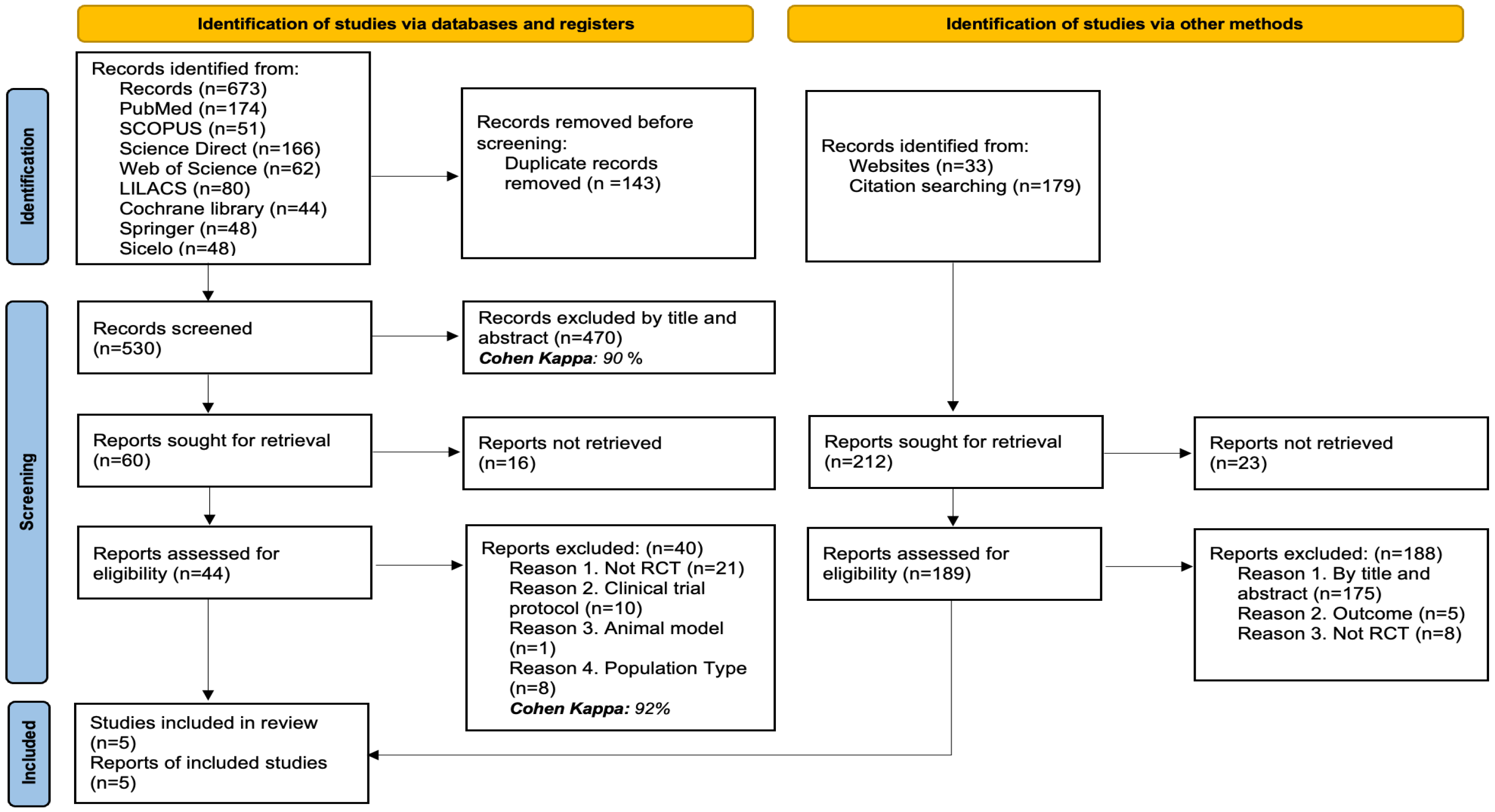
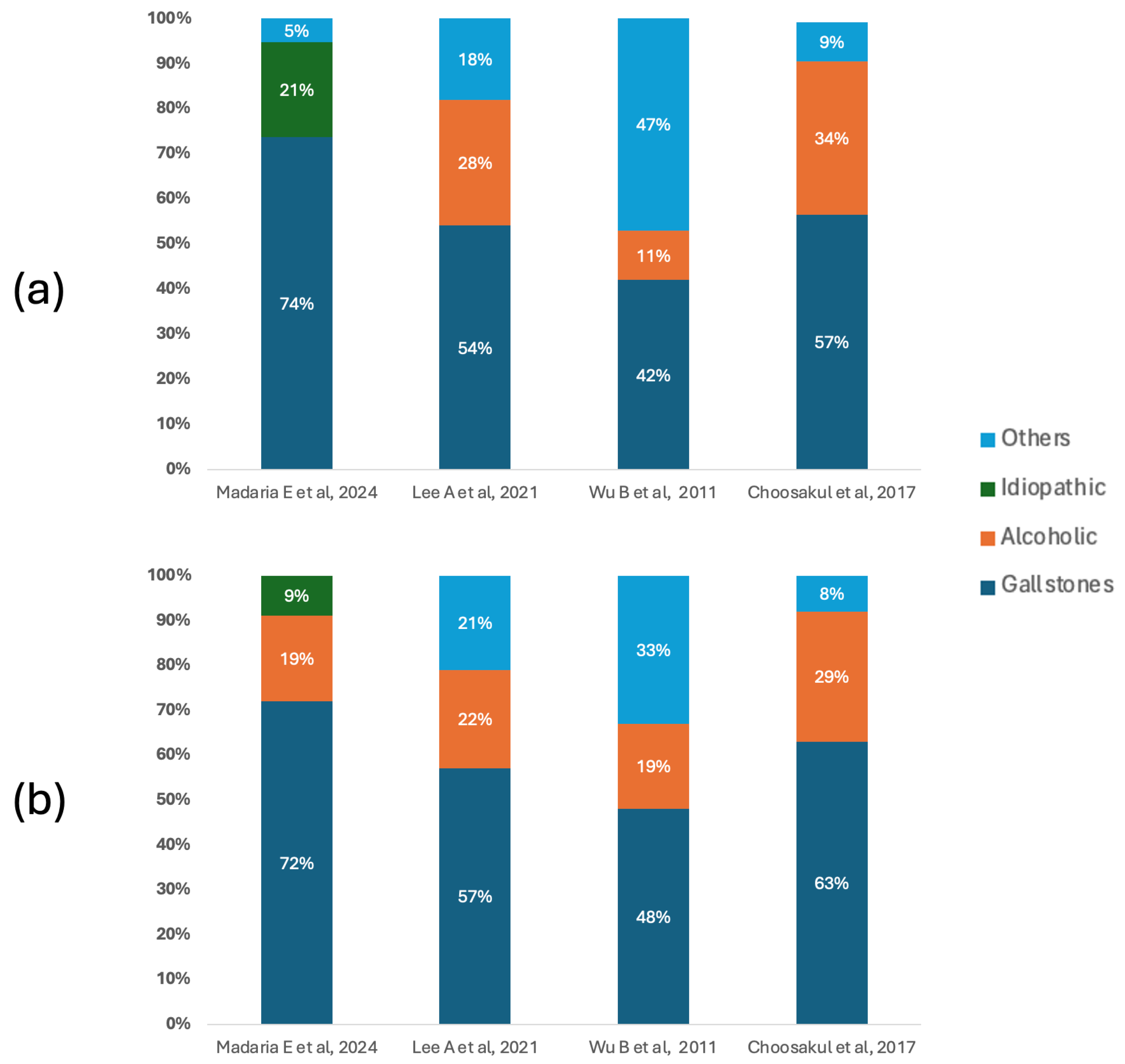


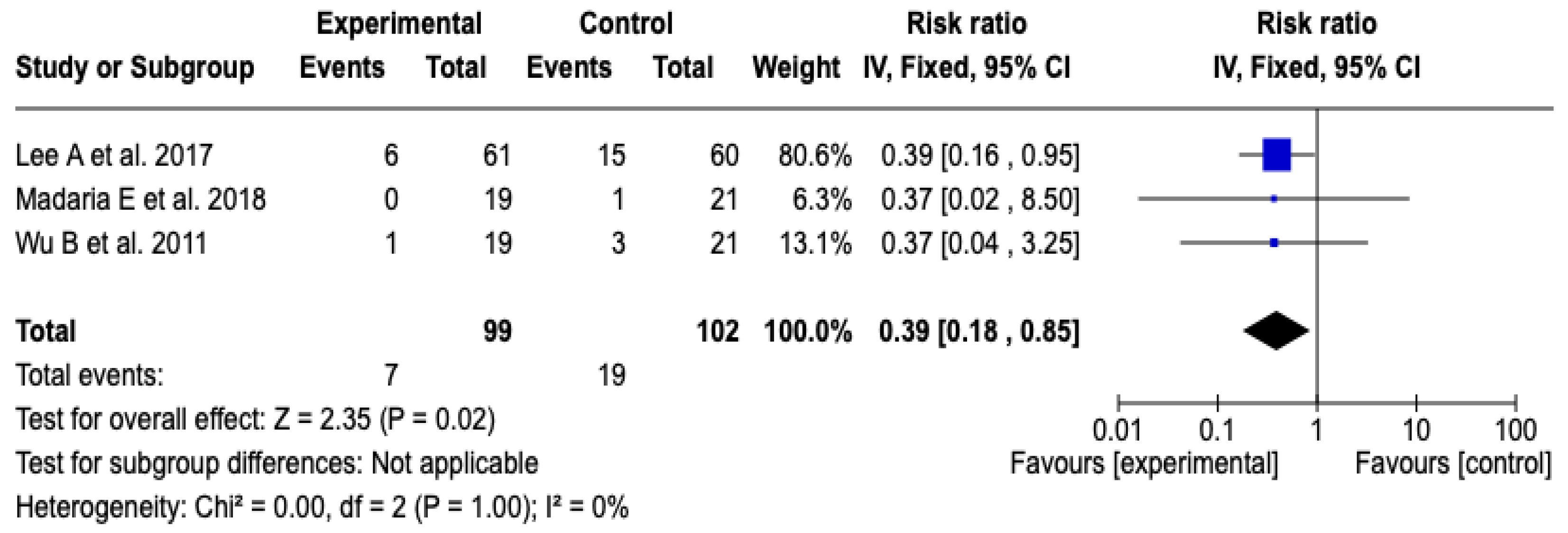
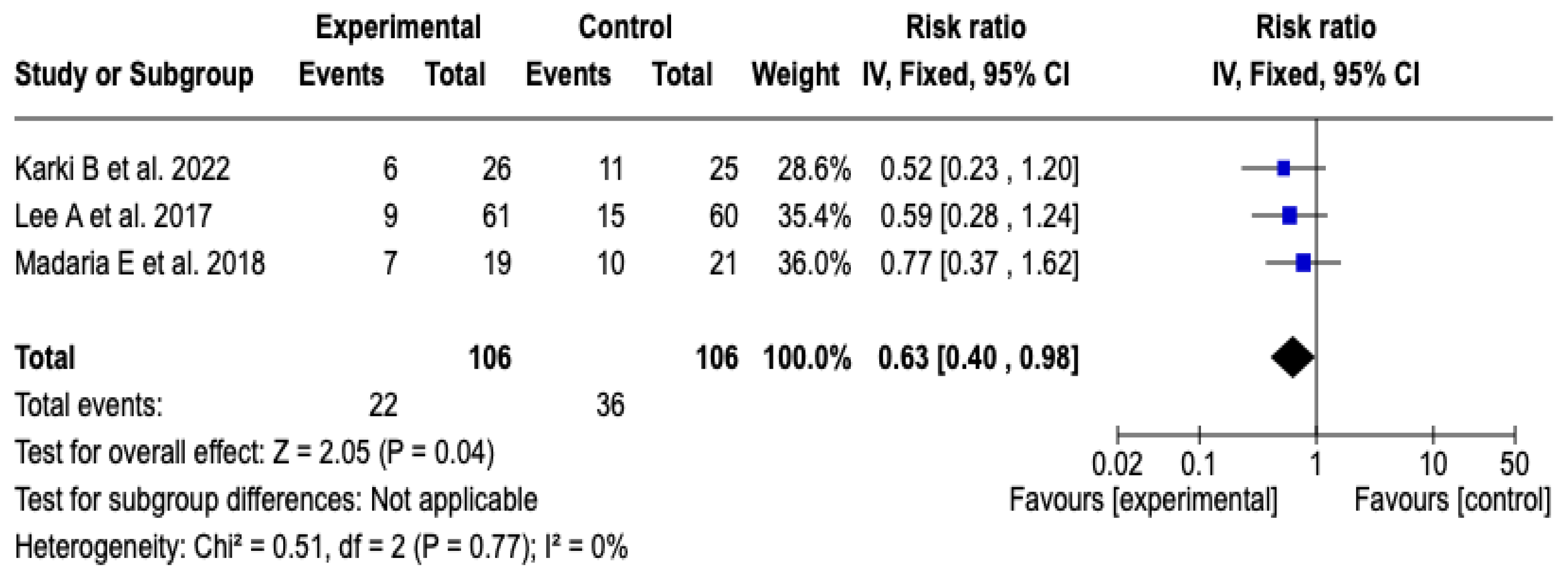
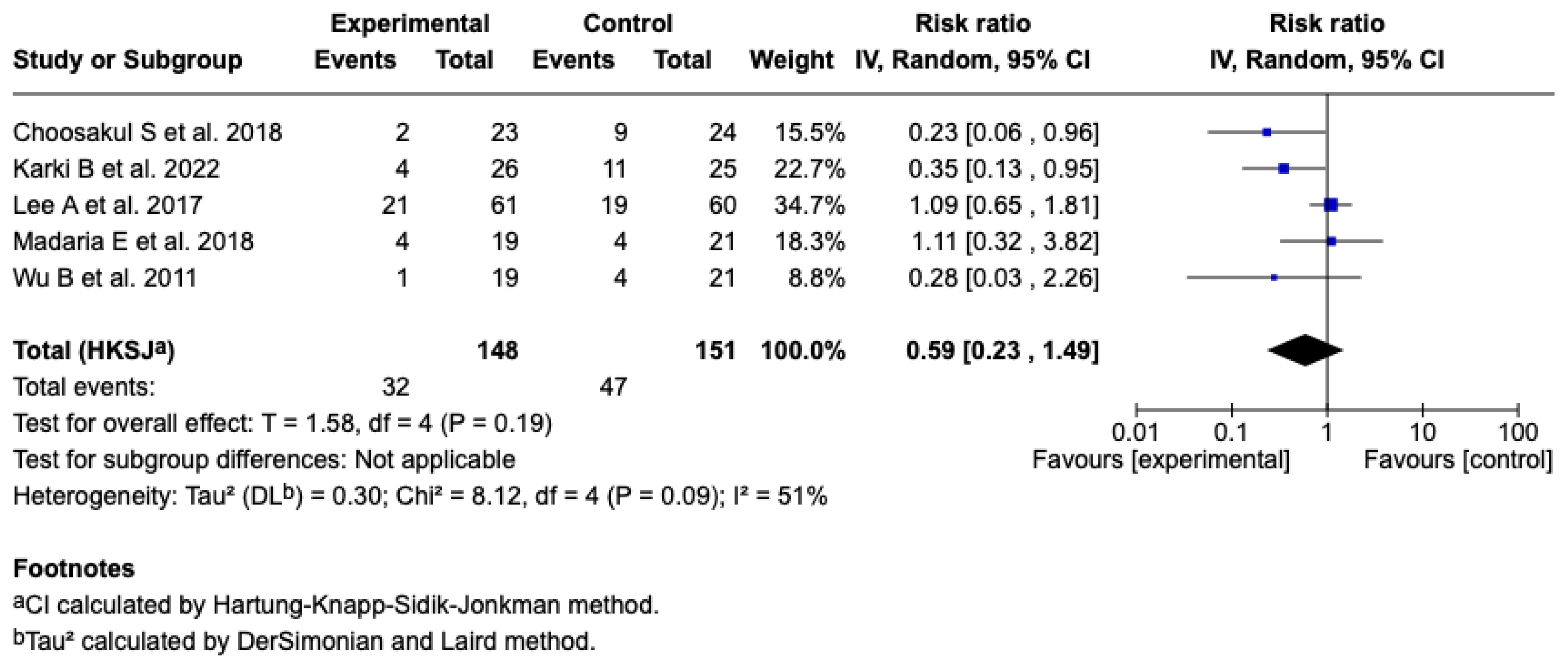




| Author | Year | Country | Study Type | Inclusion Criteria | Exclusion Criteria | Outcomes |
|---|---|---|---|---|---|---|
| Karki B et al. [25] | 2022 | Nepal | RCT | (1) Abdominal pain. (2) Amylase and/or lipase > 3 times the upper normal limit. (3) Cross-sectional abdominal imaging showing changes consistent with acute pancreatitis. (4) Adult patients. | (1) Symptoms for more than 48 h before coming to the hospital. (2) Being referred after initial resuscitation at another hospital. (3) Having a known history of severe cardiovascular, respiratory, renal, hepatic, hematological, or immunological disease. | Hospital stay, SIRS, progression of pancreatitis, CRP, and mortality. |
| Lee A et al. [26] | 2021 | USA | RCT | (1) Abdominal pain. (2) Amylase and/or lipase > 3 times the upper normal limit. (3) Cross-sectional abdominal imaging showing changes consistent with acute pancreatitis. (4) Adult patients. | (1) Patient with severe pancreatitis according to ATLANTA criteria. (2) History of chronic kidney disease, atrial fibrillation, liver dysfunction, pregnant, clinical signs of hypovolemia. | Hospital stay, ICU admission, SIRS, progression of pancreatitis, mortality, and adverse events. |
| Madaria E et al. [27] | 2018 | Spain | RCT | (1) Abdominal pain. (2) Amylase and/or lipase > 3 times the upper normal limit. (3) Cross-sectional abdominal imaging showing changes consistent with acute pancreatitis. (4) Adult patients. | (1) Time from onset of pain to randomization > 24 h. (2) Known history of chronic kidney disease, atrial fibrillation, chronic obstructive pulmonary disease, tuberculosis, and HIV. | Hospital stay, ICU admission, SIRS, progression of pancreatitis, CRP, and mortality. |
| Choosakul S et al. [28] | 2018 | Thailand | RCT | (1) Abdominal pain. (2) Amylase and/or lipase > 3 times the upper normal limit. (3) Characteristic findings of acute pancreatitis on tomography. (4) Adult patients. | (1) Post-ERCP acute pancreatitis. (2) NYHA class II heart failure, active myocardial ischemia. (3) Liver cirrhosis, chronic kidney disease, and cardiovascular intervention < 60 days. | Hospital stay, SIRS, CRP, and mortality. |
| Wu B et al. [29] | 2011 | USA | RCT | (1) Epigastric abdominal pain. (2) Amylase and/or lipase > 3 times the upper normal limit. (3) Confirmatory finding on cross-sectional imaging. (4) Over 18 years old. | (1) NYHA class II heart failure, active myocardial ischemia. (2) Cardiovascular intervention < 60 days before inclusion. (3) Chronic kidney disease, chronic obstructive pulmonary disease requiring home oxygen, sepsis, hypernatremia, and rhabdomyolysis. | Hospital stay, ICU admission, SIRS, progression of pancreatitis, CRP, mortality, and adverse events. |
| Author, Year | Population | % Female | Average Age | Fluid Resuscitation Protocol | Fluids at 24 h | Treatment Duration | Conclusions |
|---|---|---|---|---|---|---|---|
| Karki B et al. [25] | n: 51, LR: 26, NS: 25 | 49 | 41 | Initial bolus of 10 mL/kg over 60 min. Followed by an infusion of 1.5 mL/kg/h. | NR | 72 h | LR showed greater efficacy than NS in decreasing SIRS, especially in the first 24 h, with additional improvements in CRP and inflammatory parameters at 72 h. There were no differences in local complications. |
| Lee A et al. [26] | n: 121, LR: 61, NS: 60 | 44 | 43 | Initial bolus of 10 mL/kg over 2 h, followed by a continuous infusion of 3 mL/kg/h. | LR: 1.75 L ± 0.25, NS: 1.55 L ± 0.17 | 72 h | Although there was no difference in SIRS at 24 h, the use of LR in patients with AP reduced the need for intensive care and shortened hospitalization, consolidating its therapeutic benefit. |
| Madaria E et al. [27] | n: 40, LR: 19, NS: 21 | 53 | 63 | Initial bolus of 10 mL/kg over 60 min, followed by an infusion of 1 mL/kg/h for 3 days. | NR | 72 h | Fluid therapy with lactated ringer decreases inflammation associated with acute pancreatitis. |
| Choosakul S et al. [28] | n: 47, LR: 23, NS: 24 | 38 | 52 | Initial dose of 20 mg/kg over 30 min, followed by a continuous infusion of 3.0 mg/kg/h. | NR | 48 h | A greater reduction in SIRS was found in patients treated with LR compared to NS at 24 h. No differences in SIRS or mortality were evidenced at 48 h between the two types of solutions. |
| Wu B et al. [29] | n: 40, LR: 19, NS: 21 | 45 | 52 | Initial dose of 20 mg/kg over 30 min, followed by a continuous infusion of 3.0 mg/kg/h. | NR | 24 h | In patients with acute pancreatitis, resuscitation with Lactated Ringer was associated with less systemic inflammation compared to the use of saline during initial treatment. |
| Author | Study Is Randomized | Intervention Is Double-Blind | Study Withdrawals Are Accounted for and Described | Randomization Procedure Is Adequately | Selection Criteria | Score |
|---|---|---|---|---|---|---|
| Karki B et al., 2022 [25] | 1 | 0 | 1 | 1 | 1 | 4 |
| Lee A et al., 2021 [26] | 1 | 1 | 1 | 1 | 1 | 5 |
| Madaria E et al., 2018 [27] | 1 | 1 | 1 | 0 | 1 | 4 |
| Choosakul S et al., 2018 [28] | 1 | 1 | 1 | 1 | 1 | 5 |
| Wu B et al., 2011 [29] | 1 | 0 | 1 | 1 | 1 | 4 |
| Outcome | Effect Size (RR, MD or SMD) | GRADE Certainty |
|---|---|---|
| Hospital stay | SMD: −0.89 (−2.26 to 0.48) | ⬤◯◯◯ |
| ICU Admission | RR: 0.39 (0.18 to 0.85) | ⬤⬤◯◯ |
| Progression of AP | RR: 0.63 (0.40 to 0.98) | ⬤⬤◯◯ |
| SIRS at 24 h | RR: 0.59 (0.23 to 1.49) | ⬤⬤◯◯ |
| SIRS at 48 h | RR: 0.83 (0.52 to 1.34) | ⬤⬤⬤◯ |
| SIRS at 72 h | RR: 0.64 (0.35 to 1.16) | ⬤⬤◯◯ |
| CRP at 48 h | SMD: −3.91 (−4.66 to −3.17) | ⬤⬤⬤⬤ |
| CRP at 72 h | SMD: −4.92 (−17.67 to 7.83) | ⬤⬤◯◯ |
Disclaimer/Publisher’s Note: The statements, opinions and data contained in all publications are solely those of the individual author(s) and contributor(s) and not of MDPI and/or the editor(s). MDPI and/or the editor(s) disclaim responsibility for any injury to people or property resulting from any ideas, methods, instructions or products referred to in the content. |
© 2025 by the authors. Licensee MDPI, Basel, Switzerland. This article is an open access article distributed under the terms and conditions of the Creative Commons Attribution (CC BY) license (https://creativecommons.org/licenses/by/4.0/).
Share and Cite
Mosquera, F.E.C.; Benítez, E.C.; Benavides, M.C.C.; Muñoz, J.E.C.; Castañeda, C.A.; Liscano, Y. Fluid Resuscitation with Lactated Ringer vs. Normal Saline in Acute Pancreatitis: A Systematic Review and Meta-Analysis of Clinical Trials. Diseases 2025, 13, 300. https://doi.org/10.3390/diseases13090300
Mosquera FEC, Benítez EC, Benavides MCC, Muñoz JEC, Castañeda CA, Liscano Y. Fluid Resuscitation with Lactated Ringer vs. Normal Saline in Acute Pancreatitis: A Systematic Review and Meta-Analysis of Clinical Trials. Diseases. 2025; 13(9):300. https://doi.org/10.3390/diseases13090300
Chicago/Turabian StyleMosquera, Freiser Eceomo Cruz, Elizabeth Camacho Benítez, Mariatta Catalina Ceballos Benavides, Julián Esteban Castillo Muñoz, Carlos Andrés Castañeda, and Yamil Liscano. 2025. "Fluid Resuscitation with Lactated Ringer vs. Normal Saline in Acute Pancreatitis: A Systematic Review and Meta-Analysis of Clinical Trials" Diseases 13, no. 9: 300. https://doi.org/10.3390/diseases13090300
APA StyleMosquera, F. E. C., Benítez, E. C., Benavides, M. C. C., Muñoz, J. E. C., Castañeda, C. A., & Liscano, Y. (2025). Fluid Resuscitation with Lactated Ringer vs. Normal Saline in Acute Pancreatitis: A Systematic Review and Meta-Analysis of Clinical Trials. Diseases, 13(9), 300. https://doi.org/10.3390/diseases13090300






